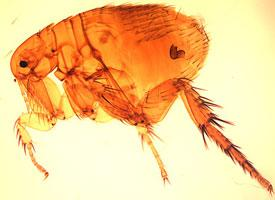
Descrierea animalului
The Oriental rat flea, scientifically known as Xenopsylla cheopis, is a small, wingless insect that plays a significant role in the transmission of various diseases, most notably the bubonic plague. This species of flea is primarily found in tropical and subtropical climates but can adapt to various environments as long as its preferred hosts, primarily rats, are present.Adult Oriental rat fleas are typically about 1 to 4 millimeters in length, making them almost invisible to the naked eye. They possess a laterally compressed body, which aids in moving through the fur or feathers of their hosts. Their color ranges from dark brown to almost black, allowing them to blend into the shadows and go unnoticed. The flea's exoskeleton is hard and shiny, providing protection against physical damage and dehydration. Despite lacking wings, Xenopsylla cheopis is an adept jumper, capable of leaping distances many times its body length thanks to its powerful hind legs. This ability facilitates its movement between hosts or when escaping perceived threats.
The mouthparts of the Oriental rat flea are specially adapted for piercing skin and sucking blood. They have a complex feeding mechanism that allows them to draw blood efficiently while simultaneously injecting saliva that contains anticoagulants to prevent the blood from clotting. This saliva can transmit pathogens from the flea to the host, making the Oriental rat flea a potent vector for disease.
One of the most infamous diseases associated with Xenopsylla cheopis is the bubonic plague, caused by the bacterium Yersinia pestis. The fleas become infected by feeding on the blood of a host that carries the bacterium. The bacterium then multiplies within the flea's gut, sometimes causing a blockage that prevents the flea from digesting its blood meals properly. As a result, the starving flea bites more frequently and aggressively, thereby increasing the chances of transmitting the disease to other hosts, including humans.
In addition to the bubonic plague, the Oriental rat flea can transmit murine typhus (caused by Rickettsia typhi) and tapeworms (Hymenolepis diminuta) among others. Its role in these transmissions, coupled with its preference for living in close proximity to human dwellings, makes it a significant public health concern in affected areas.
The life cycle of Xenopsylla cheopis is holometabolous, meaning it goes through complete metamorphosis including egg, larva, pupa, and adult stages. This process can be influenced by environmental conditions such as temperature and humidity, as well as the availability of hosts. Under optimal conditions, the entire life cycle can be completed in just a few weeks, allowing populations to grow rapidly and increasing the potential for disease outbreaks.
Control measures for Oriental rat fleas include maintaining cleanliness to reduce hiding places for rats, using pesticides to kill fleas, and treating pets with flea control products. Public health campaigns also focus on educating the public about the risks of flea-borne diseases and how to minimize them.
In conclusion, the Oriental rat flea, Xenopsylla cheopis, is a small yet formidable insect that has had a significant impact on human history through its role in transmitting diseases. Its biological characteristics and behaviors have enabled it to thrive in close association with human populations, making it a persistent threat to public health in many parts of the world.
Fotografii noi cu animale
Top 10 animale
- Dolphin gull (Leucophaeus scoresbii)
- Diana monkey (Cercopithecus diana)
- Moustached guenon (Cercopithecus cephus)
- Stone loach (Barbatula barbatula)
- Greek tortoise (Testudo graeca)
- Galápagos tortoise (Geochelone nigra complex)
- Japanese macaque (Macaca fuscata)
- Russian tortoise (Testudo horsfieldii)
- Common flying dragon (Draco volans)
- Galápagos penguin (Spheniscus mendiculus)